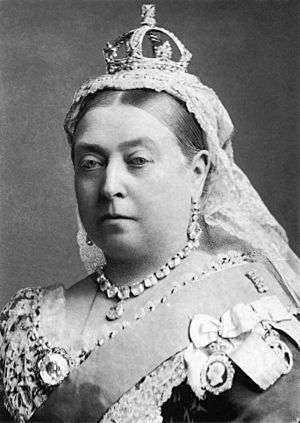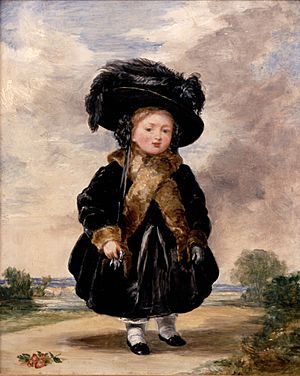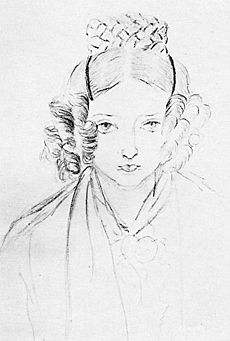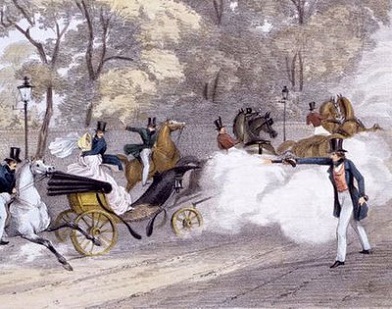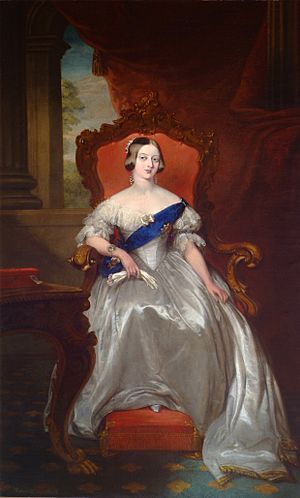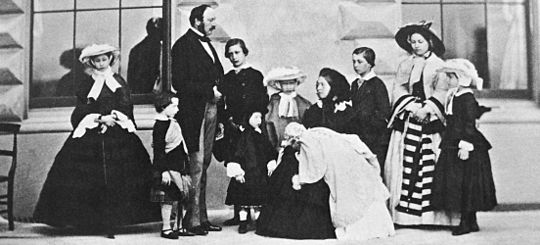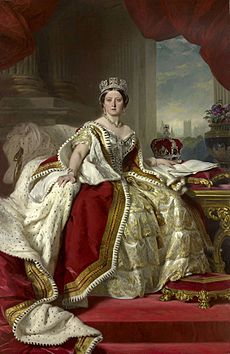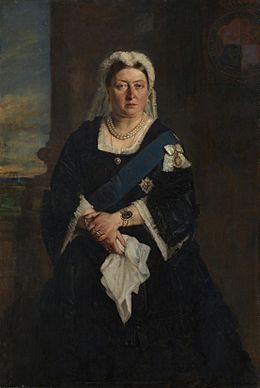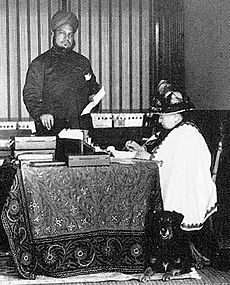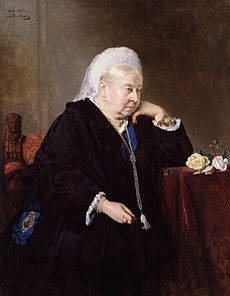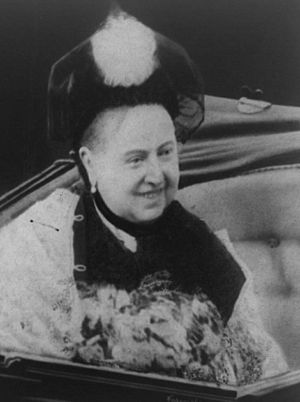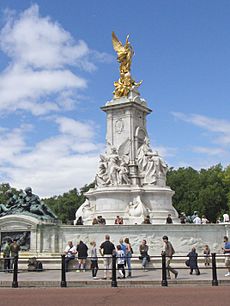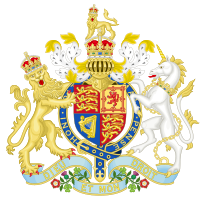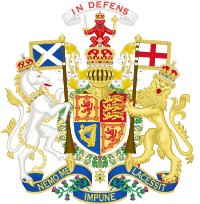Queen Victoria facts for kids
Victoria (born Alexandrina Victoria; 24 May 1819 – 22 January 1901) was the Queen of the United Kingdom of Great Britain and Ireland. She reigned from 20 June 1837 until her death in 1901. Her time as queen, lasting over 63 years, was longer than any other British ruler before her. This period is known as the Victorian era. It was a time of big changes in factories, government, science, and the military in the United Kingdom. The British Empire also grew much larger. In 1876, the British Parliament gave her the extra title of Empress of India.
Victoria was the daughter of Prince Edward, Duke of Kent and Strathearn, who was the fourth son of King George III. Her mother was Princess Victoria of Saxe-Coburg-Saalfeld. After her father and grandfather died in 1820, she was raised very carefully by her mother and her manager, John Conroy. She became queen at 18 because her father's three older brothers had no children who lived. Victoria was a constitutional monarch, meaning she had to follow rules set by Parliament. She tried to secretly influence government decisions. In public, she became a symbol of the nation, known for her strong personal values.
Victoria married her cousin Prince Albert of Saxe-Coburg and Gotha in 1840. Their children married into royal families all over Europe. This led to Victoria being called "the grandmother of Europe". After Albert died in 1861, Victoria was very sad and stayed out of public view for a long time. Because she was so private, some people in Britain wanted to get rid of the monarchy. But later in her reign, she became popular again. Her Golden and Diamond celebrations were big public parties. Victoria died at 81 in 1901 at Osborne House on the Isle of Wight. She was the last British ruler from the House of Hanover. Her son Edward VII from the House of Saxe-Coburg and Gotha became king after her.
Contents
Victoria's Early Life
Victoria's father was Prince Edward, Duke of Kent and Strathearn. He was the fourth son of the King, George III. In 1817, the King's only grandchild died. This meant there was a problem with who would rule next. So, Victoria's father and his brothers were encouraged to marry and have children. In 1818, the Duke of Kent married Princess Victoria of Saxe-Coburg-Saalfeld. She was a German princess who had two children already. Victoria, their only child, was born on 24 May 1819 at Kensington Palace in London.
Victoria was given the names Alexandrina and Victoria when she was christened. Alexandrina was for one of her godparents, Tsar Alexander I of Russia. Victoria was for her mother.
When Victoria was born, she was fifth in line to the throne. Her father died in January 1820, when she was less than a year old. A week later, her grandfather King George III died. His oldest son became King George IV. Victoria was then third in line. When King George IV died in 1830, his brother William became King William IV. Victoria then became the next in line to the throne.
Growing Up as a Princess
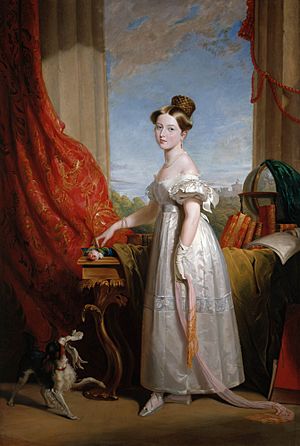
Victoria later said her childhood was "rather sad". Her mother was very protective. Victoria grew up mostly away from other children. This was part of a strict plan called the "Kensington System". Her mother and her manager, Sir John Conroy, created these rules. The system stopped Victoria from meeting people they didn't like. It was meant to make her weak and depend on them. Victoria shared a bedroom with her mother every night. She had private teachers and played with her dolls and her dog, Dash. She learned French, German, Italian, and Latin. But she spoke only English at home.
From 1830, her mother and Conroy took Victoria on trips around England and Wales. People welcomed Victoria with excitement. But King William IV was annoyed. He thought these trips made Victoria look like she was trying to compete with him. Victoria didn't like the trips either. The many public appearances made her tired and sick. She tried to stop them because the King didn't like them. But her mother ignored her and made her continue. As a teenager, Victoria refused when her mother and Conroy tried to make Conroy her private secretary. Once she became queen, she did not allow him near her.
In 1836, Victoria's uncle Leopold, who was King of Belgium, wanted her to marry his nephew, Prince Albert. Albert was the son of Leopold's brother. Leopold arranged for Albert to visit Victoria in May 1836. King William IV did not approve of Albert. He wanted Victoria to marry a Dutch prince instead. Victoria met many princes. She wrote in her diary that she liked Albert right away. She thought he was "extremely handsome" and had a "most delightful" expression. She described the Dutch prince as "very plain". Victoria wrote to her uncle Leopold, thanking him for the "great happiness" Albert brought her. She said Albert had "every quality that could be desired". At 17, Victoria was not ready to marry yet. But everyone expected the marriage to happen later.
Becoming Queen

Victoria turned 18 on 24 May 1837. This meant a regent was not needed to rule for her. Less than a month later, on 20 June 1837, King William IV died at 71. Victoria became Queen of the United Kingdom. She wrote in her diary that her mother woke her at 6 AM. The Archbishop of Canterbury and Lord Conyngham were there to see her. Lord Conyngham told her that her uncle, the King, had died. This meant that she was Queen. She was first called Alexandrina Victoria, but she asked for her first name to be removed.
Since 1714, Britain had shared a ruler with Hanover in Germany. But in Hanover, women could not inherit the throne. So, while Victoria became Queen of Britain, her uncle Ernest Augustus became King of Hanover. He was next in line to the British throne until Victoria had a child.
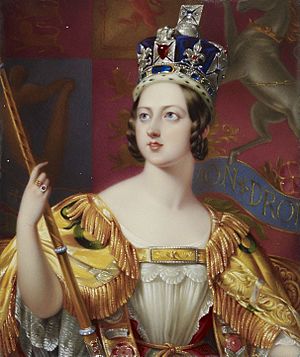
When Victoria became queen, the government was led by Prime Minister Lord Melbourne. He quickly became a strong influence on the young queen. She relied on him for advice. Victoria probably saw him as a father figure. Her coronation happened on 28 June 1838 at Westminster Abbey. Over 400,000 people came to London for the celebrations. She was the first ruler to live at Buckingham Palace. She also used her own money to pay off her father's debts.
Early in her reign, Victoria was popular. But her reputation suffered in 1839. One of her mother's ladies-in-waiting, Lady Flora Hastings, became ill. There were rumors that she was pregnant. Victoria believed these rumors. She disliked Lady Flora because she had worked with Conroy in the Kensington System. Lady Flora was later examined and found not to be pregnant. Conroy and Lady Flora's family started a campaign in the newspapers. They said the Queen was spreading false rumors. When Lady Flora died, it was found she had a large tumor. At public events, people sometimes booed Victoria.
In 1839, Lord Melbourne resigned as Prime Minister. Victoria asked a new leader, Robert Peel, to form a government. It was normal for the Prime Minister to choose people for the Royal Household. Many of Victoria's ladies were wives of Melbourne's party. Peel wanted to replace them with wives of his own party. Victoria refused to let them go. This was called the "bedchamber crisis". Peel refused to lead the government under these rules. So, Melbourne returned to office.
Marriage and Family Life
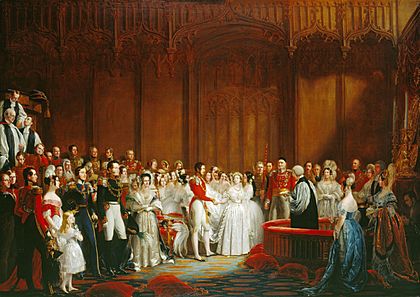
Even though Victoria was queen, as a young unmarried woman, she was expected to live with her mother. This was despite their disagreements. Victoria's mother was given a separate apartment in Buckingham Palace. Victoria often refused to see her. Victoria complained to Melbourne that her mother's closeness would cause "torment". Melbourne agreed that marriage could solve this. Victoria was interested in Albert's education for his future role as her husband. But she didn't want to rush into marriage.
Albert visited again in October 1839. Victoria continued to praise him. Albert and Victoria liked each other very much. The Queen proposed to him on 15 October 1839. They were married on 10 February 1840, at St James's Palace in London. Victoria was deeply in love. Albert became a very important adviser to the Queen. He replaced Melbourne as the main influential person in her early life. Victoria's mother moved out of the palace. Later, Victoria and her mother's relationship slowly got better.
During Victoria's first pregnancy in 1840, an 18-year-old named Edward Oxford tried to shoot her. She was riding in a carriage with Prince Albert. Oxford fired twice, but the bullets missed. He was found not guilty because of mental illness. He was sent to a mental hospital. After this attack, Victoria became very popular. Her first daughter, also named Victoria, was born on 21 November 1840. The Queen did not like being pregnant. She thought newborn babies were not pretty. But over the next 17 years, she and Albert had eight more children.
Victoria's childhood teacher, Baroness Louise Lehzen, helped run the royal household. Lehzen had been a big help to Victoria against the Kensington System. But Albert thought Lehzen was not good at her job. He believed she was harming his daughter's health. After a big argument between Victoria and Albert, Lehzen left in 1842. Victoria's close friendship with her ended.
Years with Albert
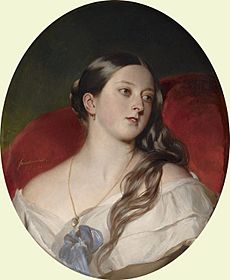
In 1842, another man named John Francis tried to shoot Victoria while she was in her carriage. The gun didn't fire. The next day, Victoria drove the same way, hoping to catch him. Francis shot at her again, but plainclothes police caught him. He was found guilty of treason. Later, another man, John William Bean, also tried to shoot the Queen. His gun was only loaded with paper and tobacco. He was sent to jail. In 1849, William Hamilton fired a pistol at her carriage. In 1850, Victoria was hit by a cane by a former army officer, Robert Pate. Both Hamilton and Pate were sent away for seven years.
Melbourne's government became weaker. In the 1841 election, his party lost. Robert Peel became Prime Minister. The Queen's ladies who were linked to Melbourne's party were replaced.
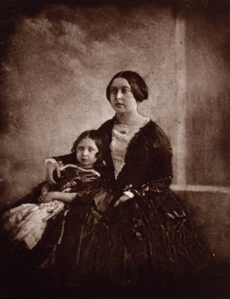
In 1845, Ireland suffered a potato blight. Over the next four years, more than a million Irish people died. Another million left the country. This was called the Great Famine. Some people in Ireland called Victoria "The Famine Queen". But she personally gave a large amount of money to help. She gave more than any other person. She also supported a Catholic seminary in Ireland, even though some Protestants were against it.
In 1846, Peel's government faced a problem with the Corn Laws. These laws kept food prices high. Many people were against changing them. But Peel, some of his party, most of Melbourne's party, and Victoria supported changing them. Peel resigned in 1846 after the change passed. Lord John Russell became Prime Minister.
| Victoria's British Prime Ministers | |
| Year | Prime Minister (party) |
|---|---|
| 1835 | Viscount Melbourne (Whig) |
| 1841 | Sir Robert Peel (Conservative) |
| 1846 | Lord John Russell (W) |
| 1852 (Feb) | Earl of Derby (C) |
| 1852 (Dec) | Earl of Aberdeen (Peelite) |
| 1855 | Viscount Palmerston (Liberal) |
| 1858 | Earl of Derby (C) |
| 1859 | Viscount Palmerston (L) |
| 1865 | Earl Russell [Lord John Russell] (L) |
| 1866 | Earl of Derby (C) |
| 1868 (Feb) | Benjamin Disraeli (C) |
| 1868 (Dec) | William Gladstone (L) |
| 1874 | Benj. Disraeli [Ld Beaconsfield] (C) |
| 1880 | William Gladstone (L) |
| 1885 | Marquess of Salisbury (C) |
| 1886 (Feb) | William Gladstone (L) |
| 1886 (July) | Marquess of Salisbury (C) |
| 1892 | William Gladstone (L) |
| 1894 | Earl of Rosebery (L) |
| 1895 | Marquess of Salisbury (C) |
| See List of prime ministers of Queen Victoria for details of her British and overseas premiers |
|
Victoria was very interested in making relations better between France and Britain. She visited King Louis Philippe I in France in 1843 and 1845. She was the first British ruler to visit a French monarch since 1520. When Louis Philippe visited Britain in 1844, he was the first French king to visit a British ruler. Louis Philippe lost his throne in the revolutions of 1848. He then came to live in England. In April 1848, Victoria and her family left London for the safety of Osborne House. This was a private home they bought in 1845. Protests in the UK did not get much support, and the fear died down. Victoria's first visit to Ireland in 1849 was popular. But it did not stop Irish nationalism from growing.
Queen Victoria did not like Russell's government. She especially disliked the Foreign Secretary, Lord Palmerston. He often made decisions without asking the Prime Minister or the Queen. Victoria complained that Palmerston sent messages to foreign leaders without her knowing. But Palmerston stayed in his job. He kept acting on his own. In 1851, Palmerston was removed. This was after he approved of President Louis-Napoleon Bonaparte's actions in France without talking to the Prime Minister. The next year, Bonaparte became Emperor Napoleon III. Russell's government was replaced by a short-lived government led by Lord Derby.
In 1853, Victoria had her eighth child, Leopold. She used a new medicine called chloroform to help with the pain. She was so impressed that she used it again in 1857 for her ninth and last child, Beatrice. This was despite some people thinking it was wrong or dangerous. Victoria may have felt sad after some of her pregnancies. Albert's letters sometimes mentioned her losing control. For example, after Leopold's birth, Albert wrote about her "continuance of hysterics" over small things.
In early 1855, the government led by Lord Aberdeen fell. This was because of problems managing British troops in the Crimean War. Victoria asked both Derby and Russell to form a government. But neither had enough support. So, Victoria had to appoint Palmerston as Prime Minister.
Napoleon III, who was Britain's closest friend because of the Crimean War, visited London in April 1855. From 17 to 28 August that year, Victoria and Albert visited France. They met Napoleon III in Boulogne and went with him to Paris. They visited a big exhibition and Napoleon I's tomb. They were also special guests at a large ball at the Palace of Versailles. This was the first time a British ruler had visited Paris in over 400 years.
On 14 January 1858, an Italian refugee tried to harm Napoleon III with a bomb made in England. This caused problems between countries. Palmerston resigned. Derby became Prime Minister again. Victoria and Albert went to the opening of a new port in Cherbourg, France, in August 1858. Napoleon III wanted to show Britain that his military plans were not aimed at them. When she returned, Victoria wrote to Derby. She told him that the British Navy was not as strong as the French Navy. Derby's government did not last long. In June 1859, Victoria asked Palmerston to be Prime Minister again.
Eleven days after the bomb attempt in France, Victoria's oldest daughter married Prince Frederick William of Prussia. They had been engaged since 1855, when Princess Victoria was 14. The Queen and Albert waited until she was 17 to marry. The Queen and Albert hoped their daughter would bring new, more open ideas to Prussia. The Queen felt "sick at heart" to see her daughter leave England for Germany. She wrote to Princess Victoria, "It really makes me shudder... when I look round to all your sweet, happy, unconscious sisters, and think I must give them up too – one by one." Almost a year later, Princess Victoria had the Queen's first grandchild, Wilhelm. He would become the last German Emperor.
Victoria as a Widow
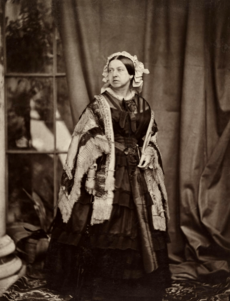
In March 1861, Victoria's mother died. Victoria was by her side. Reading her mother's papers, Victoria found out her mother had loved her deeply. She was heartbroken. She blamed Conroy and Lehzen for keeping her and her mother apart. To help his wife with her sadness, Albert took on most of her duties. He was also ill himself. In December 1861, Albert became very sick. He was diagnosed with typhoid fever and died on 14 December 1861. Victoria was devastated. She wore black clothes for the rest of her life. She avoided public events and rarely went to London. People called her the "widow of Windsor". She gained weight from eating for comfort. This made her want to avoid public even more.
Victoria's choice to stay out of public view made the monarchy less popular. It also encouraged people who wanted to get rid of the monarchy. She still did her official government duties. But she stayed mostly at her homes: Windsor Castle, Osborne House, and Balmoral Castle in Scotland. In March 1864, someone put a sign on Buckingham Palace. It said the palace was "to be let or sold" because the "occupant's declining business". Her uncle Leopold told her to appear in public. She agreed to visit gardens and drive through London in an open carriage.

In the 1860s, Victoria relied more and more on a Scottish servant named John Brown. There were rumors that they were in a romantic relationship. Some people even called the Queen "Mrs. Brown". Victoria published a book, Leaves from the Journal of Our Life in the Highlands. It talked a lot about Brown and praised him.
Palmerston died in 1865. After a short time with Russell as Prime Minister, Derby returned to power. In 1866, Victoria attended the opening of Parliament for the first time since Albert's death. The next year, she supported the Reform Act 1867. This law gave more working men the right to vote. But she did not support votes for women. Derby resigned in 1868. Benjamin Disraeli became Prime Minister. He was very charming to Victoria. Disraeli's government lasted only a few months. At the end of the year, his rival, William Ewart Gladstone, became Prime Minister. Victoria found Gladstone much less charming. She thought he spoke to her like she was a "public meeting".
In 1870, some people in Britain wanted a republic. This was partly because the Queen stayed hidden. A protest in Trafalgar Square demanded Victoria's removal. In 1871, she was very ill with an infection in her arm. It was treated successfully. In late 1871, her son, the Prince of Wales, got typhoid fever. This was the disease that was thought to have killed his father. Victoria was afraid her son would die. But he recovered. Mother and son went to a public parade and a church service in London. After this, people's desire for a republic went down.
In February 1872, a 17-year-old named Arthur O'Connor waved an unloaded pistol at Victoria's carriage. This happened just after she arrived at Buckingham Palace. John Brown grabbed him. O'Connor was later sent to prison. After this event, Victoria's popularity grew even more.
Empress of India
After the Indian Rebellion of 1857, the British East India Company no longer ruled India. Britain officially took control of India. The Queen had a balanced view of the conflict. She condemned bad actions on both sides. She wrote about her "horror and regret at the result of this bloody civil war". She insisted that the official announcement about the change in power should show "generosity, kindness and religious toleration". She asked for a part threatening local religions to be changed. It was replaced with a promise of religious freedom.
In the 1874 election, Disraeli became Prime Minister again. He passed a law that removed Catholic rituals from the Anglican church. Victoria strongly supported this. She liked short, simple church services. She felt closer to the Presbyterian Church of Scotland than the Episcopal Church of England. Disraeli also passed a law in 1876. This allowed Victoria to take the title "Empress of India" from 1 May 1876. The new title was announced at a big event in Delhi on 1 January 1877.
On 14 December 1878, the same day Albert had died, Victoria's second daughter Alice died. She had married Louis of Hesse. Alice died of diphtheria. Victoria noted that the dates were "almost incredible and most mysterious". In May 1879, Victoria became a great-grandmother. She also turned 60. She felt "aged" by the loss of her "beloved child".
Between 1877 and 1878, Victoria threatened to give up her throne five times. She was trying to make Disraeli act against Russia during a war. But her threats did not change anything. Disraeli's foreign policy, which Victoria supported, led to wars like the Anglo-Zulu War and the Second Anglo-Afghan War. Victoria believed that expanding the British Empire was good. She thought it protected local people from cruel rulers. She said, "It is not in our custom to annex countries, unless we are obliged & forced to do so." To Victoria's sadness, Disraeli lost the 1880 election. Gladstone became Prime Minister again. When Disraeli died the next year, Victoria was very sad. She put up a memorial for him.
Later Years
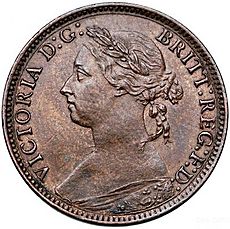
On 2 March 1882, a poet named Roderick Maclean shot at the Queen. This happened as her carriage left Windsor railway station. He was angry because Victoria refused one of his poems. Two schoolboys hit him with their umbrellas until a policeman took him away. Victoria was angry when he was found not guilty because of mental illness. But she was happy about all the support she received. She said it was "worth being shot at—to see how much one is loved".
In March 1883, Victoria fell down some stairs at Windsor. This made her unable to walk well until July. She never fully recovered and had rheumatism after that. John Brown died 10 days after her accident. Victoria started writing a book praising Brown. Her private secretary and others advised her not to publish it. They feared it would restart rumors of a love affair. The book was destroyed. In 1884, Victoria published More Leaves from a Journal of a Life in the Highlands. This book was a follow-up to her earlier one. She dedicated it to her "devoted personal attendant and faithful friend John Brown". The day after the first anniversary of Brown's death, Victoria learned her youngest son, Leopold, had died. She called him "the dearest of my dear sons". The next month, Victoria's youngest child, Beatrice, fell in love with Prince Henry of Battenberg. Victoria first opposed the marriage. She wanted Beatrice to stay home as her companion. After a year, she agreed. They promised to continue living with her.
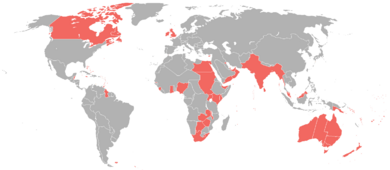
Victoria was happy when Gladstone resigned in 1885. His budget was defeated. She thought his government was "the worst I have ever had". She blamed him for the death of General Gordon in Khartoum. Lord Salisbury replaced Gladstone. Salisbury's government lasted only a few months. Victoria had to ask Gladstone to return. She called him a "half crazy & really in many ways ridiculous old man". Gladstone tried to pass a law to give Ireland more self-rule. But to Victoria's delight, it was defeated. In the next election, Gladstone's party lost. Salisbury's party took over the government again.
Golden Jubilee Celebration
In 1887, the British Empire celebrated Victoria's Golden Jubilee. This marked 50 years since she became queen. On 20 June, she had a banquet with 50 kings and princes. The next day, she took part in a procession. She also attended a church service in Westminster Abbey. By this time, Victoria was very popular again. Two days later, she hired two Indian Muslim waiters. One was Abdul Karim. He was soon promoted to "Munshi". He taught her Urdu and worked as a clerk. Her family and staff were upset. They accused Abdul Karim of spying. Victoria said their complaints were about race. Abdul Karim stayed in her service until her death. He then returned to India with a pension.
Victoria's oldest daughter became Empress of Germany in 1888. But she became a widow just over three months later. Victoria's oldest grandchild became German Emperor Wilhelm II. Victoria and Albert had hoped for a more open Germany. But Wilhelm believed in ruling with total power. Victoria thought he had "little heart or Zartgefühl [tact]".
Gladstone returned to power after the 1892 election. He was 82 years old. Victoria did not want Gladstone to appoint a certain politician to his team. So Gladstone agreed not to. In 1894, Gladstone retired. Without asking him, Victoria appointed Lord Rosebery as Prime Minister. His government was weak. The next year, Lord Salisbury replaced him. Salisbury remained Prime Minister for the rest of Victoria's reign.
Diamond Jubilee Celebration
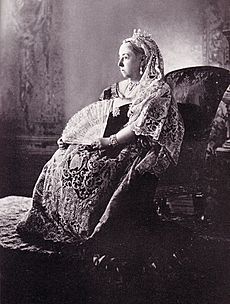
On 23 September 1896, Victoria became the longest-reigning monarch in British history. She had ruled longer than her grandfather George III. The Queen asked for special celebrations to wait until 1897. This was to match her Diamond Jubilee. It was made a big festival for the British Empire. The leaders of all the self-governing parts of the Empire were invited to London. Foreign leaders were not invited. This was partly to avoid inviting Victoria's grandson Wilhelm II of Germany. People feared he might cause problems.
The Queen's Diamond Jubilee procession on 22 June 1897 was six miles long. It went through London. Troops from all over the empire were in it. The procession stopped for a church service outside St Paul's Cathedral. Victoria stayed in her open carriage. This was so she didn't have to climb the steps. Many people watched the celebration. They showed great love for the 78-year-old Queen.
Victoria often visited Europe for holidays. In 1889, she became the first British ruler to visit Spain. This was during a stay in Biarritz. By April 1900, the Boer War was very unpopular in Europe. So, her yearly trip to France seemed like a bad idea. Instead, the Queen went to Ireland for the first time since 1861. This was partly to thank Irish soldiers in the war.
Death and Succession
In July 1900, Victoria's second son, Alfred, died. She wrote in her journal, "Oh, God! My poor darling Affie gone too". She added, "It is a horrible year, nothing but sadness & horrors of one kind & another."
Victoria spent Christmas of 1900 at Osborne House. This was a custom she kept after Albert's death. Her legs were affected by rheumatism. Her eyesight was poor because of cataracts. In early January, she felt "weak and unwell". By mid-January, she was "drowsy... dazed, [and] confused". She died on 22 January 1901, at 81 years old. Her oldest son, Albert Edward, became King Edward VII. Edward and her grandson Wilhelm II were at Victoria's deathbed. Her favorite dog, Turi, was placed on her deathbed as a last wish.
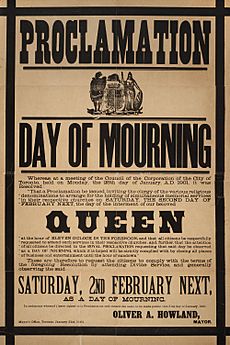
In 1897, Victoria had written instructions for her funeral. She wanted it to be military, like a soldier's funeral. She also wanted white instead of black. On 25 January, her sons Edward and Arthur, and her grandson Wilhelm, helped put her body in the coffin. She was dressed in a white dress and her wedding veil. Many items remembering her family and friends were placed in the coffin with her. One of Albert's dressing gowns was placed by her side. A lock of John Brown's hair and his picture were placed in her left hand. Her funeral was on Saturday, 2 February, at St George's Chapel, Windsor Castle. After two days, she was buried next to Prince Albert in the Royal Mausoleum, Frogmore.
Victoria reigned for 63 years, seven months, and two days. She was the longest-reigning British monarch. She was also the longest-reigning queen in world history until her great-great-granddaughter Elizabeth II surpassed her in 2015. Victoria was the last British ruler from the House of Hanover. Her son Edward VII belonged to her husband's House of Saxe-Coburg and Gotha.
Victoria's Impact
Victoria wrote a lot during her adult life. She wrote about 2,500 words a day. From 1832 until just before her death, she kept a detailed journal. It filled 122 books. After Victoria died, her youngest daughter, Princess Beatrice, was in charge of her writings. Beatrice copied and edited the diaries. She burned the original copies. But much of the diaries still exist.
Victoria was not very tall or fancy in her looks. She was about 5 feet (1.5 meters) tall. But she managed to show a grand image. She was not popular in the first years after Albert died. But she was well-liked in the 1880s and 1890s. She became a symbol of the empire as a kind mother figure. Only after her diary and letters were released did people know how much she influenced politics.
During Victoria's reign, Britain slowly became a modern constitutional monarchy. This means the power of the House of Commons grew. The power of the House of Lords and the monarch became less. In 1867, Walter Bagehot wrote that the monarch only had "the right to be consulted, the right to encourage, and the right to warn". Victoria's monarchy became more about being a symbol than about politics. It focused on good values and family. The idea of the "family monarchy" became strong. Middle-class families could relate to it.
Victoria's Descendants and Haemophilia
Victoria's connections to Europe's royal families earned her the nickname "the grandmother of Europe". Victoria and Albert had 42 grandchildren. 34 of them lived to be adults. Their living descendants include Charles III of the United Kingdom; Harald V of Norway; Carl XVI Gustaf of Sweden; Margrethe II of Denmark; and Felipe VI of Spain.
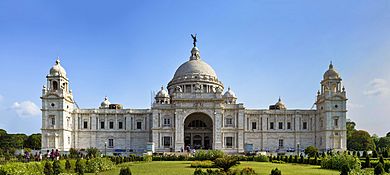
Victoria's youngest son, Leopold, had haemophilia B. This is a disease where blood does not clot properly. At least two of her five daughters, Alice and Beatrice, carried the gene for it. Royal haemophiliacs who were descendants of Victoria include her great-grandsons, Alexei Nikolaevich, Tsarevich of Russia; Alfonso, Prince of Asturias; and Infante Gonzalo of Spain. The disease was present in Victoria's descendants but not in her family before her. This led to some people wondering if her true father was not the Duke of Kent. However, there is no proof of a haemophiliac in her mother's family. It is more likely that the change in the gene happened by chance. This can happen more often when fathers are older. Victoria's father was over 50 when she was born.
Titles, Honours, and Coat of Arms
Titles
At the end of her reign, the Queen's full title was: "Her Majesty Victoria, by the Grace of God, of the United Kingdom of Great Britain and Ireland Queen, Defender of the Faith, Empress of India".
Honours
British Honours
- Royal Family Order of King George IV, 1826
- Founder of the Victoria Cross 5 February 1856
- Founder and Sovereign of the Order of the Star of India, 25 June 1861
- Founder and Sovereign of the Royal Order of Victoria and Albert, 10 February 1862
- Founder and Sovereign of the Order of the Crown of India, 1 January 1878
- Founder and Sovereign of the Order of the Indian Empire, 1 January 1878
- Founder and Sovereign of the Royal Red Cross, 27 April 1883
- Founder and Sovereign of the Distinguished Service Order, 6 November 1886
- Albert Medal of the Royal Society of Arts, 1887
- Founder and Sovereign of the Royal Victorian Order, 23 April 1896
Foreign Honours
- Spain:
- Dame of the Order of Queen Maria Luisa, 21 December 1833
- Grand Cross of the Order of Charles III
- Portugal:
- Dame of the Order of Queen Saint Isabel, 23 February 1836
- Grand Cross of the Order of the Immaculate Conception of Vila Viçosa
- Russia: Grand Cross of St. Catherine, 26 June 1837
- France: Grand Cross of the Legion of Honour, 5 September 1843
- Mexico/Mexican Empire:
- Grand Cross of the National Order of Guadalupe, 1854
- Grand Cross of the Imperial Order of San Carlos, 1866
- Prussia: Dame of the Order of Louise, 1st Division, 11 June 1857
- Brazil: Grand Cross of the Order of Pedro I, 3 December 1872
- Persia:
- Order of the Sun, 1st Class in Diamonds, 20 June 1873
- Order of the August Portrait, 20 June 1873
- Siam:
- Grand Cross of the White Elephant, 1880
- Dame of the Order of the Royal House of Chakri, 1887
- Hawaii: Grand Cross of the Order of Kamehameha I, with Collar, July 1881
- Serbia:
- Grand Cross of the Cross of Takovo, 1882
- Grand Cross of the White Eagle, 1883
- Grand Cross of St. Sava, 1897
- Hesse and by Rhine: Dame of the Golden Lion, 25 April 1885
- Bulgaria: Order of the Bulgarian Red Cross, August 1887
- Ethiopia: Grand Cross of the Seal of Solomon, 22 June 1897 – Diamond Jubilee gift
- Montenegro: Grand Cross of the Order of Prince Danilo I, 1897
- Saxe-Coburg and Gotha: Silver Wedding Medal of Duke Alfred and Duchess Marie, 23 January 1899
Coat of Arms
As Queen, Victoria used the royal coat of arms of the United Kingdom. She could not inherit the throne of Hanover. So, her coat of arms did not have the Hanoverian symbols used by earlier kings. Her coat of arms has been used by all the rulers after her.
Outside Scotland, the shield on the Royal Standard shows:
- First and fourth sections: Three gold lions on a red background (for England).
- Second section: A gold lion standing on its hind legs within a red border with flowers (for Scotland).
- Third section: A gold harp with silver strings on a blue background (for Ireland).
In Scotland, the first and fourth sections show the Scottish lion. The second section shows the English lions. The symbols above the shield, the mottos, and the animal supporters are also different in and outside Scotland.
| Royal arms (outside Scotland) | Royal arms (in Scotland) |
Victoria's Family
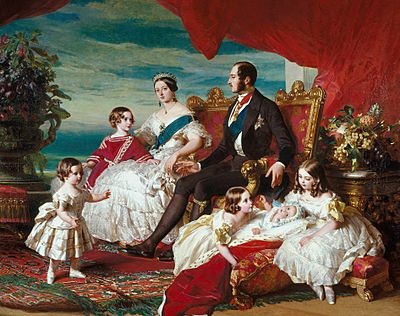
Left to right: Prince Alfred and the Prince of Wales; the Queen and Prince Albert; Princesses Alice, Helena and Victoria.
Children
| Name | Birth | Death | Spouse and children |
|---|---|---|---|
| Victoria, the Princess Royal |
1840 Nov. 21 |
1901 August 5 |
Married 1858, Frederick, later German Emperor and King of Prussia (1831–1888); 4 sons (including Wilhelm II, German Emperor), 4 daughters (including Queen Sophia of Greece) |
| Edward VII | 1841 Nov. 9 |
1910 May 6 |
Married 1863, Princess Alexandra of Denmark (1844–1925); 3 sons (including King George V of the United Kingdom), 3 daughters (including Queen Maud of Norway) |
| Princess Alice | 1843 April 25 |
1878 Dec. 14 |
Married 1862, Louis IV, Grand Duke of Hesse and by Rhine (1837–1892); 2 sons, 5 daughters (including Empress Alexandra Feodorovna of Russia) |
| Alfred, Duke of Saxe-Coburg and Gotha |
1844 August 6 |
1900 July 31 |
Married 1874, Grand Duchess Maria Alexandrovna of Russia (1853–1920); 2 sons (1 stillborn), 4 daughters (including Queen Marie of Romania) |
| Princess Helena | 1846 May 25 |
1923 June 9 |
Married 1866, Prince Christian of Schleswig-Holstein (1831–1917); 4 sons (1 stillborn), 2 daughters |
| Princess Louise | 1848 March 18 |
1939 Dec.3 |
Married 1871, John Campbell, Marquess of Lorne, later 9th Duke of Argyll (1845–1914); no issue |
| Prince Arthur, Duke of Connaught and Strathearn |
1850 May 1 |
1942 Jan. 16 |
Married 1879, Princess Louise Margaret of Prussia (1860–1917); 1 son, 2 daughters (including Crown Princess Margaret of Sweden) |
| Prince Leopold, Duke of Albany |
1853 April 7 |
1884 March 28 |
Married 1882, Princess Helena of Waldeck and Pyrmont (1861–1922); 1 son, 1 daughter |
| Princess Beatrice | 1857 April 14 |
1944 Oct. 26 |
Married 1885, Prince Henry of Battenberg (1858–1896); 3 sons, 1 daughter (Queen Victoria Eugenie of Spain) |
Ancestors
| Ancestors of Queen Victoria | |||||||||||||||||||||||||||||||||||||||||||||||||||||||||||||||||||||||||||||||||||||||||||||||||||||||||||||||||||||||||||||||||||||||||||||||||||||||||||||||||||||||||||||||||||||||||||||||||||||||||||||||||||||||||||||||||||||||||||||||||||||||||||||||||||||||||||||||||||||||||
|---|---|---|---|---|---|---|---|---|---|---|---|---|---|---|---|---|---|---|---|---|---|---|---|---|---|---|---|---|---|---|---|---|---|---|---|---|---|---|---|---|---|---|---|---|---|---|---|---|---|---|---|---|---|---|---|---|---|---|---|---|---|---|---|---|---|---|---|---|---|---|---|---|---|---|---|---|---|---|---|---|---|---|---|---|---|---|---|---|---|---|---|---|---|---|---|---|---|---|---|---|---|---|---|---|---|---|---|---|---|---|---|---|---|---|---|---|---|---|---|---|---|---|---|---|---|---|---|---|---|---|---|---|---|---|---|---|---|---|---|---|---|---|---|---|---|---|---|---|---|---|---|---|---|---|---|---|---|---|---|---|---|---|---|---|---|---|---|---|---|---|---|---|---|---|---|---|---|---|---|---|---|---|---|---|---|---|---|---|---|---|---|---|---|---|---|---|---|---|---|---|---|---|---|---|---|---|---|---|---|---|---|---|---|---|---|---|---|---|---|---|---|---|---|---|---|---|---|---|---|---|---|---|---|---|---|---|---|---|---|---|---|---|---|---|---|---|---|---|---|---|---|---|---|---|---|---|---|---|---|---|---|---|---|---|---|---|---|---|---|---|---|---|---|---|---|---|---|---|---|---|---|
|
|||||||||||||||||||||||||||||||||||||||||||||||||||||||||||||||||||||||||||||||||||||||||||||||||||||||||||||||||||||||||||||||||||||||||||||||||||||||||||||||||||||||||||||||||||||||||||||||||||||||||||||||||||||||||||||||||||||||||||||||||||||||||||||||||||||||||||||||||||||||||
Family Tree
- Red borders indicate British monarchs
- Bold borders indicate children of British monarchs
| Family of Queen Victoria, spanning the reigns of her grandfather, George III, to her grandson, George V | |||||||||||||||||||||||||||||||||||||||||||||||||||||||||||||||||||||||||||||||||||||||||||||||||||||||||||||||||||||||||||||||||||||||||||||||||||||||||||||||||||||||||||||||||||||||||||||||||||||||||||||||||||||||||||||||||||||||||||||||||||||||||||||||||||||||||||||||||||||||||||||||||||||||||||||||||||||||||||||||||||||||||||||||||||||||||||||||||||||||||||||||||||||||||||||||||||||||||||||||||||||||||||||||||||||||||||||||||||||||||||||||||||||||||||||||||||||||||||||||||||||||||||||||||||||||||||||||||||||||||||||||||||||||||||||||||||||||||||||||||||||||||||||||||||||||||||||||||||||||||||||||||||||||||||||||||||||||||||||||||||||||||||||||||||||||||||||||||||||||||||||||||||||||||||||||||||||||||||||||||||||||||||||||||||||||||||||||||||||||||||||||||||||||||||||||||||||||||||||||||||||||||||||||||||||||||||||||||||||||||||||||||||||||||||||||||||||||||||||||||||||||||||||||||||||||||||||||||||||||||||||||||||||||||||||||||||||||||||||||||||||||||||||||||||||||||||||||||||||||
|---|---|---|---|---|---|---|---|---|---|---|---|---|---|---|---|---|---|---|---|---|---|---|---|---|---|---|---|---|---|---|---|---|---|---|---|---|---|---|---|---|---|---|---|---|---|---|---|---|---|---|---|---|---|---|---|---|---|---|---|---|---|---|---|---|---|---|---|---|---|---|---|---|---|---|---|---|---|---|---|---|---|---|---|---|---|---|---|---|---|---|---|---|---|---|---|---|---|---|---|---|---|---|---|---|---|---|---|---|---|---|---|---|---|---|---|---|---|---|---|---|---|---|---|---|---|---|---|---|---|---|---|---|---|---|---|---|---|---|---|---|---|---|---|---|---|---|---|---|---|---|---|---|---|---|---|---|---|---|---|---|---|---|---|---|---|---|---|---|---|---|---|---|---|---|---|---|---|---|---|---|---|---|---|---|---|---|---|---|---|---|---|---|---|---|---|---|---|---|---|---|---|---|---|---|---|---|---|---|---|---|---|---|---|---|---|---|---|---|---|---|---|---|---|---|---|---|---|---|---|---|---|---|---|---|---|---|---|---|---|---|---|---|---|---|---|---|---|---|---|---|---|---|---|---|---|---|---|---|---|---|---|---|---|---|---|---|---|---|---|---|---|---|---|---|---|---|---|---|---|---|---|---|---|---|---|---|---|---|---|---|---|---|---|---|---|---|---|---|---|---|---|---|---|---|---|---|---|---|---|---|---|---|---|---|---|---|---|---|---|---|---|---|---|---|---|---|---|---|---|---|---|---|---|---|---|---|---|---|---|---|---|---|---|---|---|---|---|---|---|---|---|---|---|---|---|---|---|---|---|---|---|---|---|---|---|---|---|---|---|---|---|---|---|---|---|---|---|---|---|---|---|---|---|---|---|---|---|---|---|---|---|---|---|---|---|---|---|---|---|---|---|---|---|---|---|---|---|---|---|---|---|---|---|---|---|---|---|---|---|---|---|---|---|---|---|---|---|---|---|---|---|---|---|---|---|---|---|---|---|---|---|---|---|---|---|---|---|---|---|---|---|---|---|---|---|---|---|---|---|---|---|---|---|---|---|---|---|---|---|---|---|---|---|---|---|---|---|---|---|---|---|---|---|---|---|---|---|---|---|---|---|---|---|---|---|---|---|---|---|---|---|---|---|---|---|---|---|---|---|---|---|---|---|---|---|---|---|---|---|---|---|---|---|---|---|---|---|---|---|---|---|---|---|---|---|---|---|---|---|---|---|---|---|---|---|---|---|---|---|---|---|---|---|---|---|---|---|---|---|---|---|---|---|---|---|---|---|---|---|---|---|---|---|---|---|---|---|---|---|---|---|---|---|---|---|---|---|---|---|---|---|---|---|---|---|---|---|---|---|---|---|---|---|---|---|---|---|---|---|---|---|---|---|---|---|---|---|---|---|---|---|---|---|---|---|---|---|---|---|---|---|---|---|---|---|---|---|---|---|---|---|---|---|---|---|---|---|---|---|---|---|---|---|---|---|---|---|---|---|---|---|---|---|---|---|---|---|---|---|---|---|---|---|---|---|---|---|---|---|---|---|---|---|---|---|---|---|---|---|---|---|---|---|---|---|---|---|---|---|---|---|---|---|---|---|---|---|---|---|---|---|---|---|---|---|---|---|---|---|---|---|---|---|---|---|---|---|---|---|---|---|---|---|---|---|---|---|---|---|---|---|---|---|---|---|---|---|---|---|---|---|---|---|---|---|---|---|---|---|---|---|---|---|---|---|---|---|---|---|---|---|---|---|---|---|---|---|---|---|---|---|---|---|---|---|---|---|---|---|---|---|---|---|---|---|---|---|---|---|---|---|---|---|---|---|---|---|---|---|---|---|---|---|---|---|---|---|---|---|---|---|---|---|---|---|---|---|---|---|---|---|---|---|---|---|---|---|---|---|---|---|---|---|---|---|---|---|---|---|---|---|---|---|---|---|---|---|---|---|---|---|---|---|---|---|---|---|---|---|---|---|---|---|---|---|---|---|---|---|---|---|---|---|---|---|---|---|---|---|---|---|---|---|---|---|---|---|---|---|---|---|---|---|---|---|---|---|---|---|---|---|---|---|---|---|---|---|---|---|---|---|---|---|---|---|---|---|---|---|---|---|---|---|---|---|---|---|---|---|---|---|---|---|---|---|---|---|---|---|---|---|---|---|---|---|---|---|---|---|---|---|---|---|---|---|---|---|---|---|---|---|---|---|---|---|---|---|---|---|---|---|---|---|---|---|---|---|---|---|---|---|---|---|---|---|---|---|---|---|
|
|||||||||||||||||||||||||||||||||||||||||||||||||||||||||||||||||||||||||||||||||||||||||||||||||||||||||||||||||||||||||||||||||||||||||||||||||||||||||||||||||||||||||||||||||||||||||||||||||||||||||||||||||||||||||||||||||||||||||||||||||||||||||||||||||||||||||||||||||||||||||||||||||||||||||||||||||||||||||||||||||||||||||||||||||||||||||||||||||||||||||||||||||||||||||||||||||||||||||||||||||||||||||||||||||||||||||||||||||||||||||||||||||||||||||||||||||||||||||||||||||||||||||||||||||||||||||||||||||||||||||||||||||||||||||||||||||||||||||||||||||||||||||||||||||||||||||||||||||||||||||||||||||||||||||||||||||||||||||||||||||||||||||||||||||||||||||||||||||||||||||||||||||||||||||||||||||||||||||||||||||||||||||||||||||||||||||||||||||||||||||||||||||||||||||||||||||||||||||||||||||||||||||||||||||||||||||||||||||||||||||||||||||||||||||||||||||||||||||||||||||||||||||||||||||||||||||||||||||||||||||||||||||||||||||||||||||||||||||||||||||||||||||||||||||||||||||||||||||||||||
See also
 In Spanish: Victoria del Reino Unido para niños
In Spanish: Victoria del Reino Unido para niños


